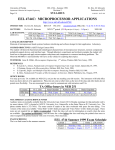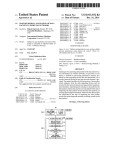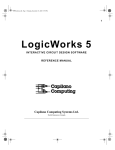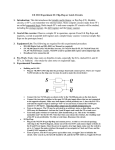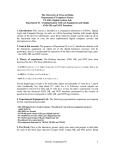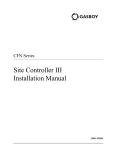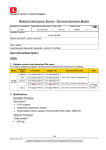Download In laboratory exercises
Transcript
EE 2310 Laboratory Experiment #4: Laboratory Design Project 1. Introduction: In laboratory exercises 1-3, you became familiar with the basic circuit elements. Today we will use these elements to design a more complex circuit. 2. Goal of this exercise: Familiarize students with the steps involved in doing a digital design. We will go through most of these steps in order to complete a small design project. 3. Theory of experiment: In real world design projects there are always limitations on what can be done during a given project, including power, size, cost, and performance, to name just a few. Today’s project will focus on one of these limitations: number of pins. Your design will be limited by the available inputs (switches) and outputs (LEDs) on the IDL-800 breadboard. A typical digital design project may go through the following steps: 1. 2. 3. Initial concept and specification High level design and verification Detailed design 4. 5. 6. Simulation Hardware implementation Final testing For today’s experiment, step 1 will be a given. You will complete steps 2,3,5, and 6. Since our design is small, we will skip step 4 (which you would never do in the real world!). We will rely on the final testing of our hardware to determine if our design is correct. 4. Experimental Equipment List: The following experimental components are required for this experimental procedure: • • • IDL-800 circuit prototype unit and User Manual (as required) Any of the devices in the digital logic kit Breadboard wire connection kit 5. Pre-Work: Make sure you are up-to-date in all readings in Tokheim and the lecture material. Although the circuit will be built in lab, you and your lab partner should proceed through the design process and try to come to lab with a first-pass design. 6. Design Process: Today you will design an 8-bit adder, using SN 74LS83 4-bit adder circuits. Your circuit will add two 8-bit numbers together (along with the carry in) and display the result on the circuit-board LED’s. As there are only 8 input switches, you will have to store one 8-bit input separately in order to provide the two inputs to the adder. Since there are only 8 LED’s for the output, you will need to be creative and design a way to display the carry out signal in addition to the sum bits. Some tips to help you get started: • • • You can only use the bank of 8 switches for the two inputs. You can use the momentary switches to help you store the inputs, provide the carry in, etc. Use the largest scale integration devices that you have. In other words, do not build a register out of flip-flop chips. Use the SN 74LS75 4-bit registers in your kit to store data as you are using the 74LS83 circuits as your 4-bit adder elements. Step 1: Draw out your initial high-level design on paper (or with a CAD system such as LogicWorks, if you purchased it). Verify that what you have drawn looks conceptually correct. Some tips to help: EE 2310: Experiment #4 • Use large functional blocks for your high-level design. That is, since you are designing an 8bit adder, start with a single 8-bit adder block. It does not matter that there is no 8-bit adder chip. As you move to a more detailed design, this block will be subdivided into actual hardware (i.e., chips that are available to you). Don’t forget your physical design limitations – the number of switches and LEDs. • Step 2: Take each large functional block and decompose it into actual hardware circuits. As noted above, you can start on the first steps at home. Step 3: Build your circuit on the breadboard. Verify the operation of the circuit. Step 4: Test the cases below and list the results in your lab report. These last two steps must be done in the lab. • • • Note: You are building an adder for positive numbers; NOT two’s complement. Add 85 (01010101) and 42 (00101010) with no carry-in and then with carry-in. Add 128 (10000000) and 127 (01111111) with no carry-in and then with carry-in. How do you display the carry out? Pick a few other binary numbers to add. Have your TA verify your results and sign your data sheet. • • 7. Equipment Disassembly: Disassemble the circuit, replace wires and parts in the kit boxes, and replace kits in the cabinet. Make sure your work area is clean and have the TA check. 8. Laboratory Report: As usual, your laboratory report should follow the on-line form. In your write-up, discuss your results. Also include the following items: • • • Discuss your experience in the laboratory and any problems with the procedure. Show the complete design. You do NOT need to show the connections to Power and Ground, nor do you need to show the circuit outlines. Discuss any insights gained from the exercises. Chip Outlines and Power Connections Notch Notch Ground (0V.) connection 1 2 3 4 5 6 7 14 13 12 11 Power (+5V.) connection Power (+5V.) connection 10 9 8 1 2 3 4 5 6 7 8 16 15 14 13 12 11 10 9 74LS83 & 74LS75 Chip Outlines 74 LS 04, 08, 32 14-Pin Chips 2 Ground (0V.) connection EE 2310: Experiment #4 Pin-outs for circuit elements needed in this laboratory: 32 08 04 13 12 11 10 9 8 5 6 3 4 1 2 3 1 2 3 4 5 6 4 5 6 9 10 8 9 10 8 12 13 11 12 13 11 1 2 SN 74LS08 Quad SN 74LS32 Quad inverter gate 2-input AND gate 2-input OR gate 14 SN 74LS04 Hex 16 4 7 11 B3 B2 B1 B0 A3 A2 A1 A0 83 4 15 S3 2 S2 6 S1 9 S0 13 7 6 3 2 CI 13 1 3 8 10 CO SN 74LS83 4-bit full adder pinouts. 3 SN 74LS75 4-bit 75 latch pin-outs – Q3 8 Note: Input pin 11 23EN Q2 14 4 is the clock for Q1 01EN Q0 1 inputs D3 and 9 D3 Q3 D4, and pin 13 is Q2 10 D2 the clock for Q1 15 D1 16 Q0 D0 inputs D1 and D2. The 74LS75 4-bit latch has both Q and Q outputs. Note that the Q outputs are pins 16, 15, 10, and 9, and the inverted outputs are 1, 14, 11, and 8.



